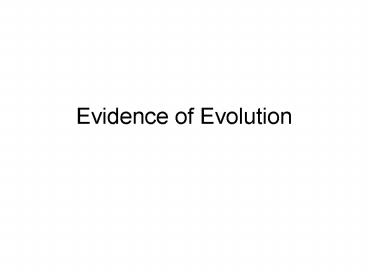Evidence of Evolution - PowerPoint PPT Presentation
1 / 16
Title:
Evidence of Evolution
Description:
Evidence of Evolution Evidence of Evolution Darwin argued that living things have been evolving on Earth for millions of years. Evidence supporting his theory could ... – PowerPoint PPT presentation
Number of Views:71
Avg rating:3.0/5.0
Title: Evidence of Evolution
1
Evidence of Evolution
2
Evidence of Evolution
- Darwin argued that living things have been
evolving on Earth for millions of years. - Evidence supporting his theory could be found
- 1. Fossil record
- Geographical distribution of living species
- Anatomy
- 4. Similarity in early development (embryology)
3
1. The Fossil Record
- Darwin saw fossils as a record of the history of
life on Earth. - Darwin proposed
- Earth was millions, rather than thousands, of
years old - Countless species had come into being, lived for
a time, and then vanished.
4
2. Geographic distribution of Living Species
- Species now living on different continents had
each descended from different ancestors. - Some animals on each continent were living under
similar ecological conditions so they were
exposed to similar pressures of natural selection.
5
Similar, But Unrelated Species
As a result, Darwin concluded that because of
these similar selection pressures, different
animals ended up evolving certain features in
common!
6
3. Anatomy
- Darwin noticed similarities among the body parts
of various animal and plants. - There are three different types of structures to
help support Darwin's Theory of Evolution. - Homologous Structures
- Analogous Structures
- Vestigial Structures
7
Homologous Structures
- Homologous Structures
- Structures that are similar and have originated
from a common ancestor. - May look different on the outside, but have
similar structure inside. - Indicates that organisms may have shared a recent
common ancestor.
8
Homologous Structures contd.
- The limbs of different organisms serve different
functions, but have the same bone structure
inside.
9
Analogous Structures
- Analogous Structures
- Structures that serve identical functions, but
have different internal anatomy. - Ex wings of birds and insects
- Both allow organisms to fly, but have different
development and structure. - Shows a more distant relationship than homologous
structures.
10
(No Transcript)
11
Identify the following structures as analogy or
homologous. Be able to defend your answer!
12
Vestigial Structures
- Vestigial structures that were useful in
ancestors but are no longer used by modern
organisms - Shows relationship between organisms with
vestigial structure and those with a working
version. - Ex humans have tailbones homologous to tails of
other animals
13
Vestigial Structures contd.
- Some organisms have genes that are conserved.
- Genes that have remained unchanged, but may be
turned off. - Ex whales have genes for hind legs
- Can give clues about early development of a
species. - Ex whales may have descended from an ancestor
who lived on land
14
4. Embryology
- Embryology study of early development
- Many organisms share similarities within the
early stages of development. - The same groups of embryonic cells develop in the
same order and in similar patterns to produce the
tissues and organs of all vertebrates. - These common cells and tissues, growing in
similar ways to produce the homologous
structures! - Can indicate a common ancestry among different
species.
15
Embryology contd.
16
Similarities in Macromolecules
- Similarities within DNA, RNA and proteins of
different species - Genetic code is universal all living things
share the same code - Closely related species have very similar gene
sequences and protein sequences. - Ex hemoglobin in humans and gorillas differs by
only 1 amino acid - Can confirm ideas suggested by anatomy and
embryology.































